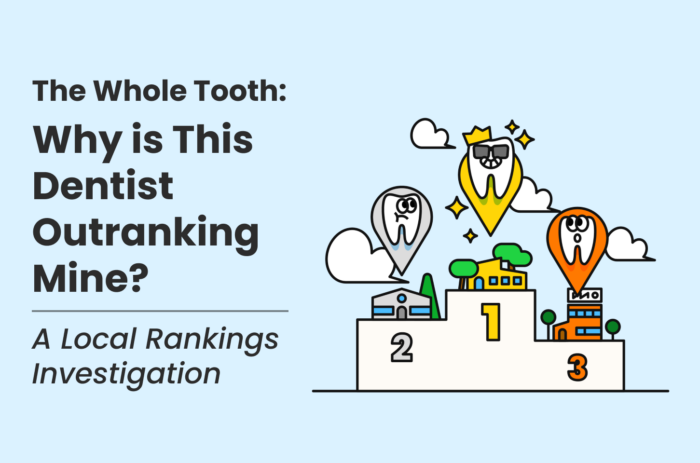- The following investigation highlights why it isn’t always clear why one business outranks another.
- We investigate why Dentist A is being outranked by Dentist B, despite the former having better performance metrics in BrightLocal's Local Search Grid (LSG) tool.
- Key areas found for Dentist A to investigate further and improve include: Keyword tracking and portfolio update; content refresh and optimization; regular review generation; fixing citation errors, adding citations and using practitioner listings.
“Why is this business outranking us?”—it’s a question we at BrightLocal hear time and time again. Whether it’s asked in our Facebook community, The Local Pack, one of our live Google Business Profile (GBP) audits, or directly to Customer Support, trust us when we say you’re not alone.
SEO is often referred to as an ongoing chess game, particularly when Google is involved—and local SEO is no different. Google’s local ranking algorithm uses various signals known as local ranking factors. These can become more prominent or less important depending on the current algorithm Google is using to rank local businesses.
In many cases, local SEO reporting will highlight some clear areas for improvement or identify what your competitors are doing better. But what do you do when it’s not obvious?
We thought we’d take a look at a real-life example to try to help.
So today, we’re diving into a real local SEO problem. Using two genuine (but anonymized in this case study) dental clinics within a mile of each other in a small town in the United States, we’ll explore how to read BrightLocal reports to identify areas for further investigation. We’ll also consider the other local ranking factors to investigate beyond those reports.
Throughout the case study, we’ll highlight some key areas for investigation or actions to take, so you can use these as guidelines for investigations with your own clients.
Starting Stats: Local Search Grid
Let’s take a look at a problem you might be faced with. Imagine you’re an agency working with Dentist A, an independent dental clinic in a small town in the northeastern US. You’ve not been subscribed to BrightLocal for long, and you’ve been getting to grips with reading the reports. So far, you’re mostly concerned with local ranking reports.
You’ve added Dentist A’s keywords to Local Search Grid (LSG). The top of your report shows the Average Map Rank for your first keyword (‘dentist’) is 7.3. It also shows 25 green grid points, which means they’re ‘high ranking’ (as in ‘in the Top 3 in the Local Pack). The orange and red points show you areas that need improvement. So far, so good.
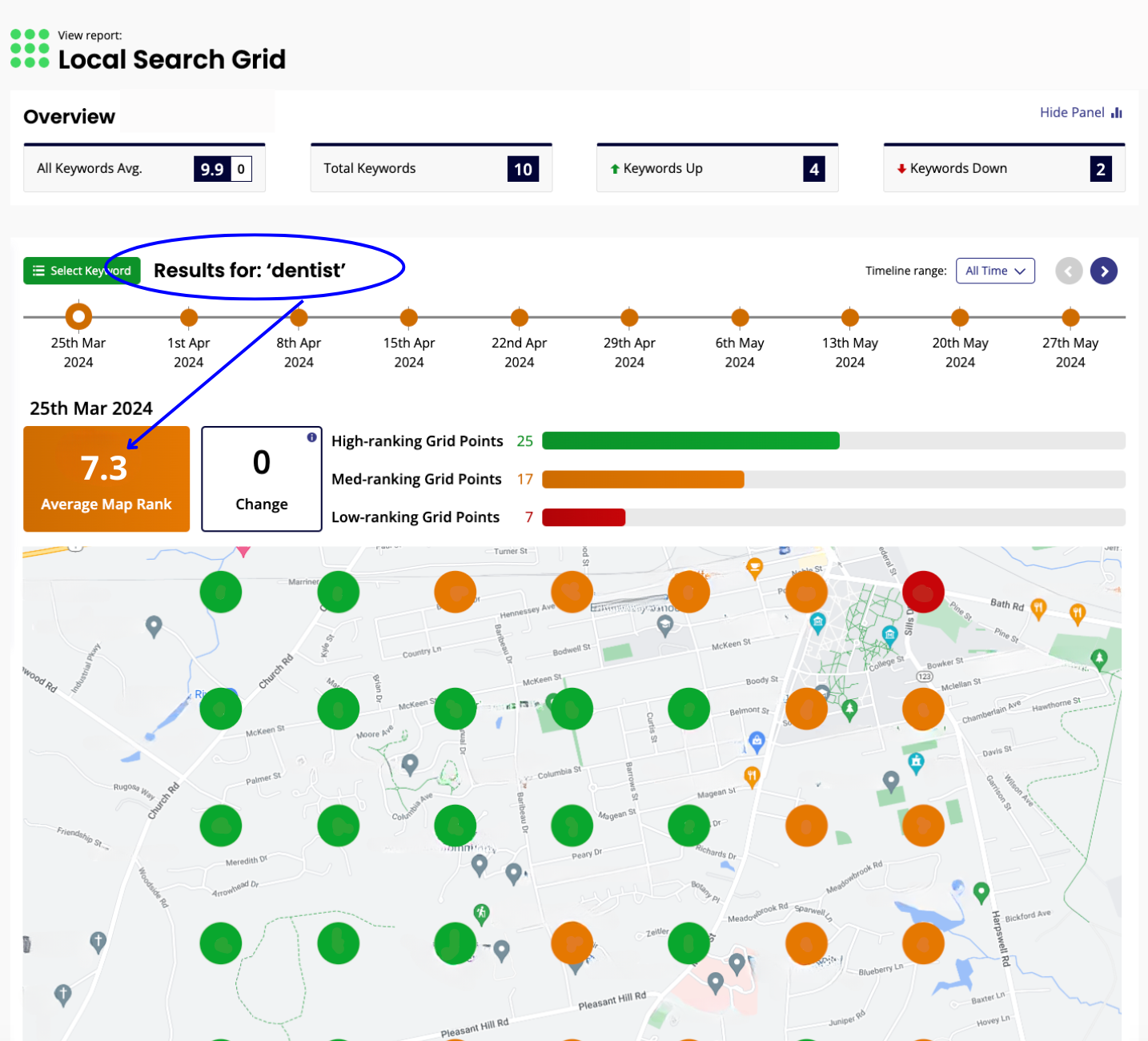
Scrolling down underneath the map image, you’re presented with a side-by-side comparison of your top local competitors. This is when you see something confusing. Dentist B, one of your closest competitors in proximity, has an Average Map Rank of 4.9, while yours is 7.3.
Two other competitors sit above Dentist B. Both have hundreds more reviews, backlinks, and a higher domain authority (DA) than you, so it’s clear why they’re performing well. But when you compare the report’s local ranking factors side-by-side, you should technically be outperforming Dentist B.
Let’s examine these factors more closely.

Despite both dental clinics’ average Google rating of 4.9 out of 5, Dentist A should have an overall advantage for this term—shouldn’t it? Yet its average local ranking is over two positions lower.
Now, we will look at our other BrightLocal reports to see if they uncover anything else.
Further Investigation with BrightLocal Tools and Reports
Local Rank Tracker and Google Business Profile Audit
Local Rank Tracker (LRT) tracks the positions of your keywords in Google and Bing over time so you can see which are gaining or losing visibility in the SERPs. Google Business Profile Audit displays a summary of your GBP’s key information, and its performance for five of your chosen keywords against local competitors. In this section, we’ll cover the two reports together as the insights feed into one another.
Tracking Changes to Your Website and GBP
Keeping notes or making annotations is a good idea when you make significant changes to your website or GBP.
This can be helpful for understanding what may be influencing the movement of your tracked terms.
You could use an internal tracking sheet or make a note of key changes within your client reports.
As well as looking at the main LRT report to see if ranking positions for keywords change over time, you can also use it to compare rankings with a chosen competitor. Let’s look at how Dentist A and Dentist B perform in Google organic desktop rankings for some of their key terms.

On the date in question, you can see that the competitor, Dentist B, is ranking for more of the key terms and outperforming Dentist A for two of them (dental clinic and emergency dentist). Now we’re getting somewhere.
So, aside from monitoring any downward movement to our key terms in the SERPs to pinpoint any changes that may have caused this, we know that Google is rewarding Dentist B with better organic rankings for these terms. The most obvious case could be that Dentist B has better optimized its website pages for this key term, while Dentist A has overlooked it.
Actions to Take
Review Any Recent Website or GBP Changes
If you have made changes recently, don’t modify or reverse them. It’s not yet clear if this will have impacted rankings, so you’ll want to monitor this over time.
Assess Competitors’ Website Content
If you regularly monitor competitors’ website content, can you see if anything significant has changed? If you’re unsure or you don’t have a record of changes, put yourself in the shoes of a prospective patient and review competitor content, asking:
- Does their website have more comprehensive service pages dedicated to services that match key terms?
- Is the content of good quality? That is, does it demonstrate expertise, experience, authority, and trustworthiness (as per Google’s E-E-A-T guidelines)?
- Is the location and its surrounding service areas clearly presented in some way?
Audit Competitor GBPs
Look up your competitor’s GBP and make note of the features being used. Compare this against your client’s GBPs to identify any gaps you may have. Ask yourself:
- Does it use Google Posts to share updates with users?
- Has it listed Services that correlate to key terms?
- Does the Q&A section have any questions in it? Have they been answered?
- Are there photos of the clinic, its team, and its facilities?
Optimizing Your Google Business Profile: Find out more about features and best practices for optimal GBP performance
Review and Update Your Keywords
As businesses change and evolve, new services are added, some may be removed, and new geographical areas may open up. It can be easy to overlook the process of reviewing and updating keyword portfolios to reflect these. However, this should not be underestimated! Tracking the ranking positions of terms that are no longer relevant to your brand is pointless and skews your focus to the wrong things.
With the above, it looks like we’ve already got a list of things we can do. It’s a good start!
Now, If we jump over to GBP Audit, we see a more visual representation of Dentist A’s GBP.
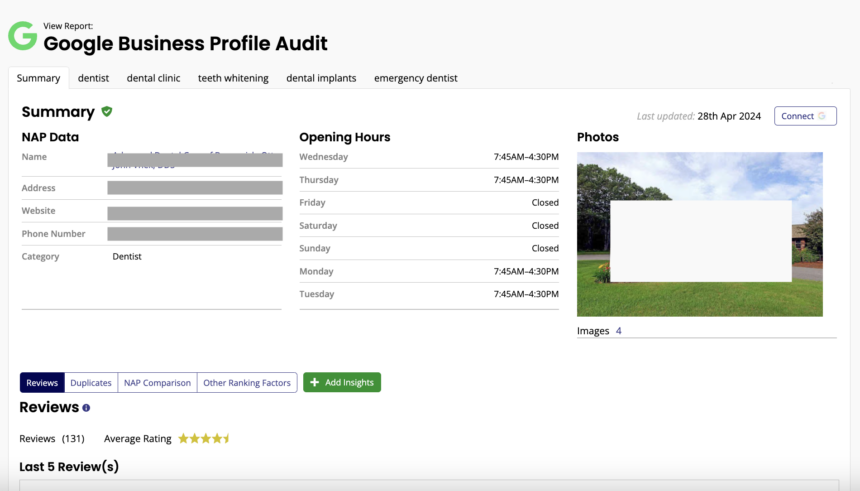
Each tab at the top lists 10 top competitors for each keyword, which builds on the information presented in Local Search Grid and Local Rank Tracker. However, we can see here several more factors to consider in order to help ranking performance:
- Whether the profile is verified
- % of Key Citations (more on this later)
- Linking domains (total linking root domains, e.g. you might see 200 links, but they might only be coming from 50 root domains)
- Number of photos
This is all well and good, but we’ve still not found the smoking gun—the metrics that really mark Dentist B out from Dentist A. Let’s move on to the next report and see what else we can unearth.
Citation Tracker
Citations are thought to be a local ranking factor, which means it’s important to ensure the businesses you are managing can be found across various online directories.
Citation Tracker (CT) is quick and simple to set up. Using your business details, CT will locate all of the citation websites you’re listed on and highlight inconsistencies and errors on key citation websites.
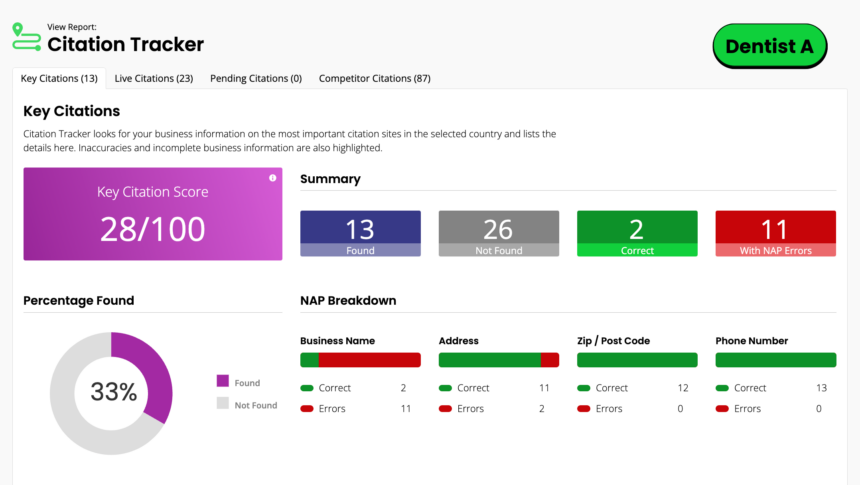
Above, we can see that Dentist A’s picture is not too rosy. The Key Citation Score of 28/100 tells us that both the quantity and quality of citations are not up to scratch. Moreover, out of the 23 live citations, only 13 are considered key citations, and 11 of those have errors—that’s close to half of Dentist A’s citations.
Simply scrolling down on this report highlights every citation and its errors. In Dentist A’s case, there are some significant differences in the business name being used across these websites.
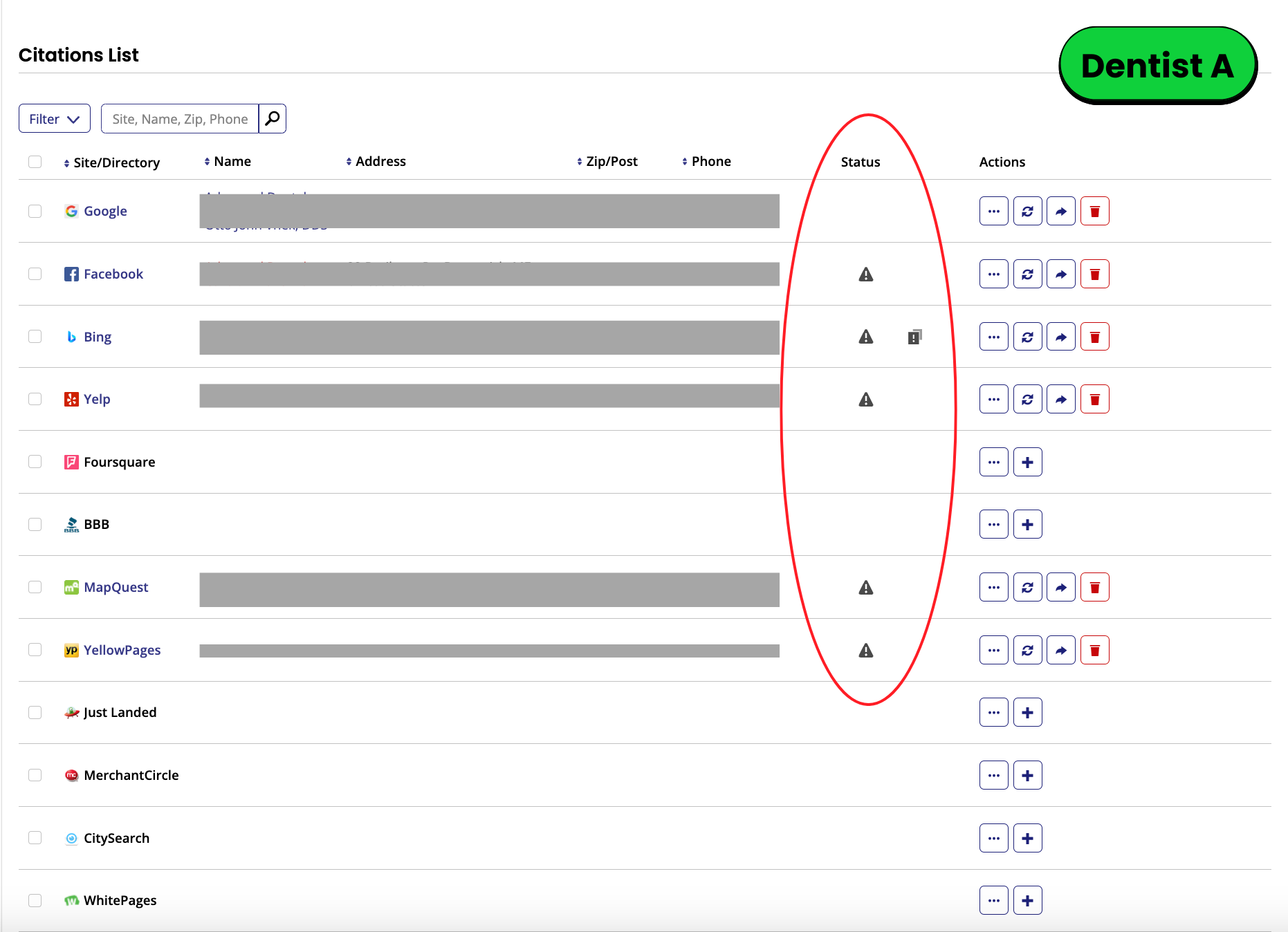
Put yourself in the shoes of a customer, and that’s a pretty confusing experience when you’re doing research—especially for an important decision associated with healthcare.
From a customer perspective, the Local Business Discovery and Trust Report 2023 investigated the implications of incorrect business information on consumer trust and found that 62% of consumers would avoid using a business if they found incorrect information online.
Competitor Citations
Adding a competitor as a location within BrightLocal and setting up its own Citation Tracker report is a simple way to compare performance and identify key citation sources you may be missing. It’s up to you whether you choose to run them as one-offs or regularly for a more consistent picture of the competition.
We went ahead and ran Dentist B’s CT report.
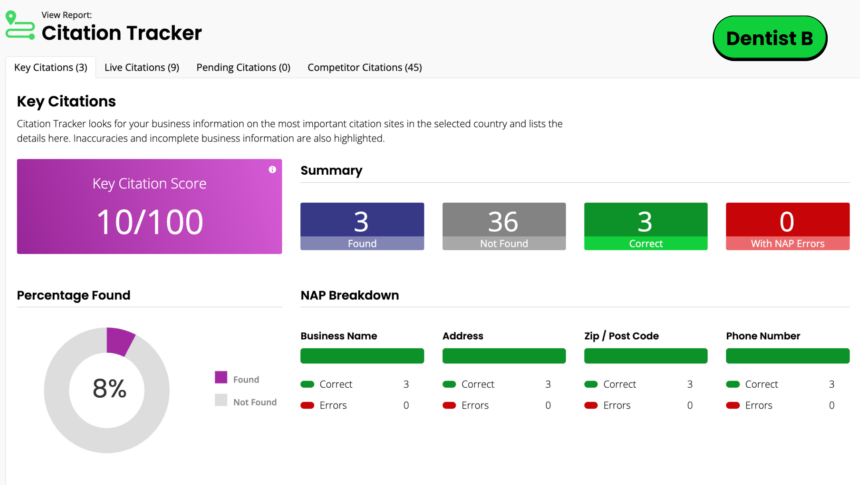
Luckily for Dentist A, Dentist B’s citations are in even worse shape, with just nine in total! However, the dashboard does not highlight any errors, while we know that Dentist A does have some to work on.
It seems like citations aren’t the make-or-break factor for Dentist B outranking Dentist A, but this doesn’t mean that cleaning up, fixing, and building new citations shouldn’t happen. It’s still important to maintain and optimize listings to ensure business information is accurate.
Actions to Take
Correct Your Citation Errors
Fixing these errors should be the first port of call. In Dentist A’s case, there are only nine to do, so this won’t be too time-consuming. For businesses with dozens of listings to fix, you can see why monitoring them regularly is important.
Within your CT dashboard, you can travel straight to the live citation and edit your listing. Or, if a colleague or client manages citation amends, you can click the status of individual citations to leave notes highlighting what needs to be done.
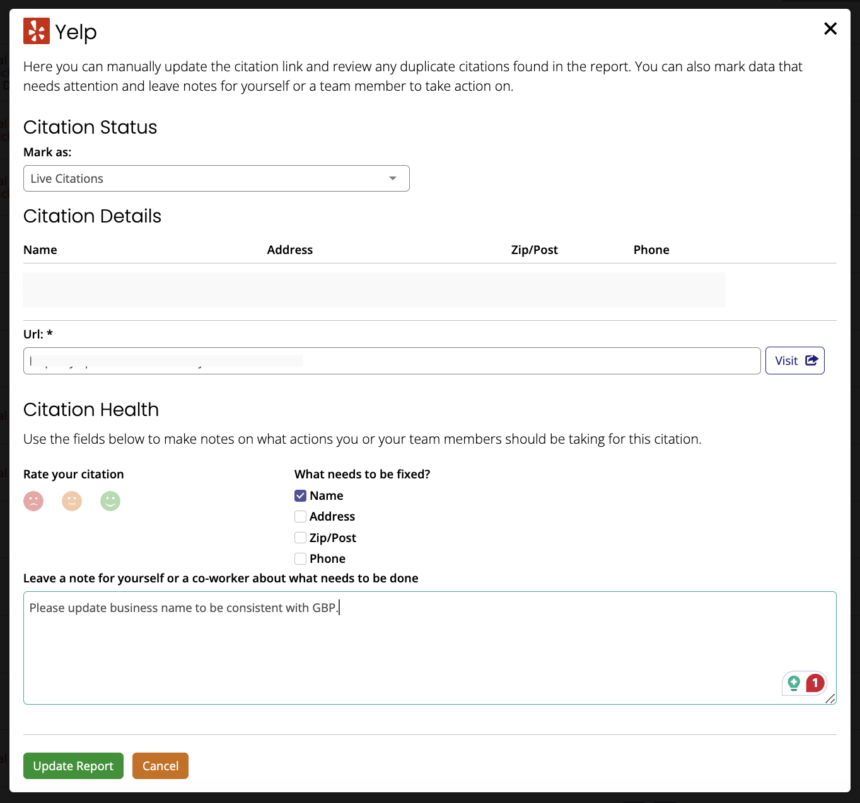
Find and Add New Citations
CT highlights the relevant citation websites where listings are not found, which can be used as a checklist to work through. You can go through and add these yourself, or consider using BrightLocal’s Citation Builder service for a fuss-free and speedy turnaround.
Reputation Manager: Monitor Reviews
Moving into the realm of reviews, Monitor Reviews is a useful dashboard as it displays review growth over time, as well as a breakdown of star ratings and the sources of where reviews are coming from.
We already know that Dentist A has an average star rating of 4.9, but there are two clear areas that need improvement.
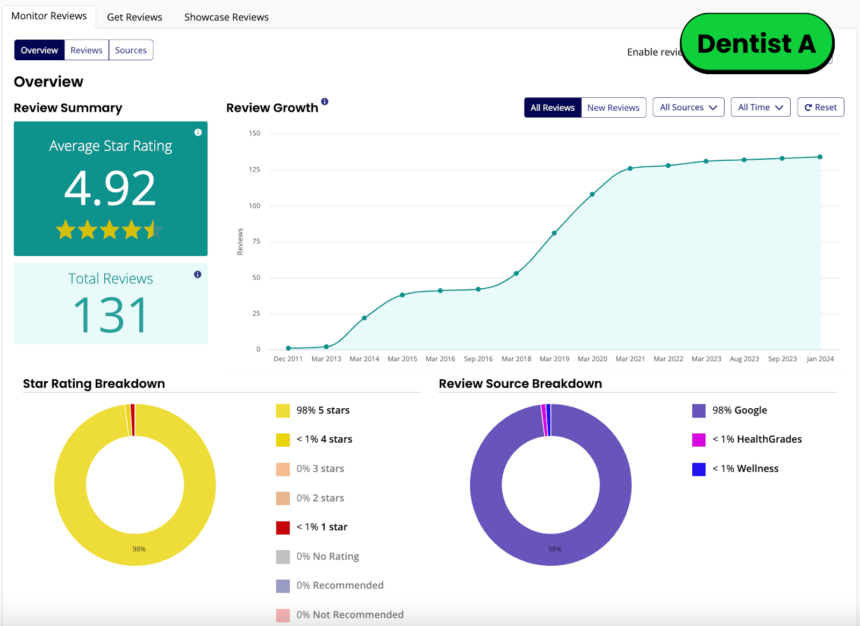
For some reason, Dentist A hasn’t received a new review since January 2024, leaving a two-month gap on the timeline. A quick manual check confirms this, so there is a clear starting point: achieving new review growth.
While the star rating breakdown is positive, the review source breakdown highlights just three sources of reviews: Google (98%), HealthGrades (<1%), and Wellness (<1%).
Diversifying review portfolios is an important consideration of reputation management. According to the Local Consumer Review 2024, 36% of consumers use at least two different review sites before deciding to use a local business.
Plus, as we highlighted earlier, ensuring consistent information across different sources, such as review platforms and citation websites, reinforces trust with consumers.
Dentist A could consider building a stronger profile on other review platforms, such as Better Business Bureau (BBB), TrustPilot, YellowPages, and Doctor.com.
Competitor Reviews
We set up a Monitor Reviews report for Dentist B to compare the review profiles of the two businesses. Although its review sources are even less diverse and have fewer total reviews than Dentist A’s, Dentist B’s review growth chart shows a constant stream of reviews month on month.
From this, we can conclude that review frequency and recency play important roles in creating what Google deems to be a trustworthy review profile.
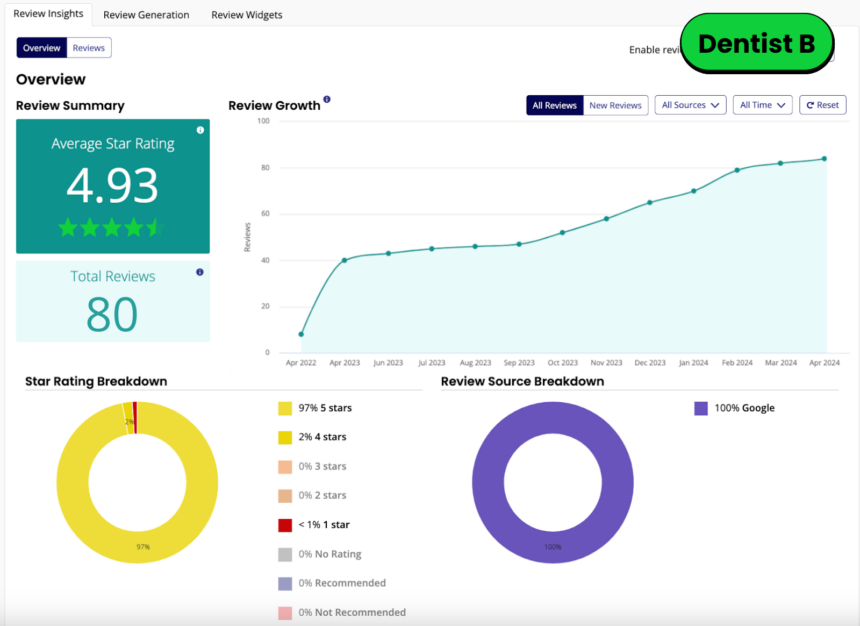
Review Responses
Heading over to Dentist A’s review profiles on Google, HealthGrades, and Wellness, another key observation is that it only replies to business reviews sporadically. Google’s guidance on improving local rankings specifically calls out managing and responding to reviews.
Plus, our findings from the Local Consumer Review Survey consistently show that consumers are more likely to use a business that responds to all types of customer reviews, whether positive or negative.
On the other hand, Dentist B doesn’t seem to reply to any business reviews. Although it appears to have the upper hand with review growth and recency, both businesses should absolutely consider review responses a priority.
Actions to Take
Create Review Campaigns to Encourage New Reviews and Diversify Sources
Clearly, relying on reviews coming in organically isn’t working out for Dentist A. Creating timely, automated review campaigns is simple and effective with Get Reviews.
Now, we can create email and SMS templates, including email follow-ups, create an NPS system for gathering useful internal feedback, and select the external review platforms we want to ask customers to use.
Local Search Audit
Local Search Audit provides an instant snapshot of your local SEO ‘health’ in an easy-to-understand traffic light system.

As we’ve already analyzed Rank Tracker, Local Listings, Reputation Manager, and GBP Audit, we’ll cover Links & Authority and On-Site SEO here.
Links and Authority
Links and Authority is rated as ‘OK.’ Further down, Local Search Audit shows the following metrics for Dentist A against the average competitor:
- Google Index count (how many of your pages are Indexed by Google): 42 vs. 20
- Link count: 285 vs. 511
- Linking domain count: 89 vs. 149
- Domain Authority: 13 vs. 14.2

Link building is an important part of local SEO as it helps build awareness and authority, boost organic visibility, and signal that brands are trustworthy.
From these stats, we can see that attaining new links and broadening linking domains should be a key focus for Dentist A to improve on.
Local Link Building: Tactics to boost your local SEO
Actions to Take
Link building is renowned for being a tricky area in SEO—you can easily dedicate a whole role to outreach. So, while an entire link-building strategy may be a lot to recommend straight away here, you can start small.
Create a List of Target Websites and Publications
Generally, a good link portfolio should consist of relevant, authoritative sources. It’s also wise to consider how you can diversify it—for Dentist A, it could be something like an article on cosmetic dentistry ahead of big events for an authoritative wedding publication.
Set Up Brand Alerts to Find Mentions of Your Business Online
This can be useful for identifying when your brand is mentioned online but has not been linked to, so you can create a list of organizations to reach out to for corrections.
Review Your Backlink Profile with a Dedicated Tool
Semrush and ahrefs are just two examples of tools that can identify your links and linking domains, as well as provide insights on competitor backlinks. Competitor backlink analysis is also a useful way of scouting out ideas for the types of content and topics that are being linked to or covered by journalists.
On-Site SEO
This section of the Local Search Audit report is a small goldmine. It counts the number of pages crawled, the number of internal links, page titles and metadata, mobile rendering, and keyword count, to name just a few.
From a technical standpoint, Local Search Audit rates Dentist A as ‘Good.’ It’s worth noting that Dentist A’s website is fairly small, with just 66 pages. Plus, although it’s given the green flag overall, a few problem areas are highlighted:
- Missing image alt tags
- Sparse content pages (<500 words)
- Google PageSpeed Score

Scrolling down, the Local Search Audit also highlights the presence of ‘Top Keywords’ across the site. Quite astonishingly, ‘dentist’ does not appear here whatsoever! As we suspected earlier in the LRT section, the key term has been completely overlooked here.
Given that Dentist A’s primary GBP category is also ‘dentist,’ this is quite a severe misstep.
Dentist A can easily begin to rectify this issue by re-optimizing key pages for the correct terms.

Actions to Take
Identify Missing or Low Count Key Terms
When it comes to fitting keywords into your website content, you never want to force it. However, this area of Local Search Audit could highlight if you are under-servicing some of your key terms.
In Dentist A’s case, the website is missing one of its priority, tracked keywords, which also correlates to its primary category in GBP.
We’ll move on to sparse content in the next section.
Beyond the Tools
We’ve identified plenty of areas that can be improved upon to boost Dentist A’s local visibility, but there are only a few clear areas where Dentist B is outperforming them so far—review regularity and local rankings.
So, with what we’ve learned from the tools and reports, how can we take some of these insights away to investigate further?
On-site Content
Unfortunately, since we’ve anonymized our dentists, we can’t show you screenshots of the websites. But for Dentist A, imagine an HTML-coded Myspace layout circa 2006 (seriously). The navigation is not particularly intuitive, and, as we just discussed, the content across the website is sparse in detail.
Local Search Audit highlighted 45 out of its 66 pages as sparse content—that’s 68% of the site’s content with pages containing less than 500 words. Although content quality doesn’t—and shouldn’t—always correspond with quantity (e.g. word count), you would expect a website in the healthcare industry to have some comprehensive content.
It’s important to have clearly defined service pages, with descriptions that outline what potential patients can expect and answer any questions they may have.
With our auditor caps on, we can already see some clear reasons why Dentist B might be outranking Dentist A from a content perspective. So, we’ve compared the two dental clinics side-by-side, rating key elements of on-site content for local SEO. (Again, we can’t show you the websites, so you’ll have to trust us on this!)
| Dentist A | Dentist B | |
|---|---|---|
| Navigation | Poor | Fair |
| Content quality | Fair | Good |
| Images on site | Fair | Poor |
| FAQs | Good | Fair |
| Contact information | Poor | Poor |
| Blog/Resources | N/A | N/A |
| Testimonials/Social Proof | Poor | Poor |
| Accolades/Certifications | Poor | Poor |
| Page optimization | Poor | Poor |
Actions to Take
Page Optimization
At the very least, take the opportunity to optimize website pages. Optimize titles and descriptions with relevant keywords and a concise character limit, and find natural opportunities to include more of your key terms in page content.
Content Refresh
Rewriting website content can be a daunting task, but it’s easier to tackle if you break pages down into priority groups. For example, you could start with your key services and work on them in batches.
Page Structure
Whether you’ll be writing the content yourself, or briefing it to a team member or freelancer, a content brief is a great way to maintain consistency with your page structures. You can include keywords, page titles, headings, and descriptions, as well as dedicated sections that need to be written and included, such as FAQs.
Research Supporting Content Ideas
Would your website benefit from a blog or dedicated area for more informational and supportive content? This type of content can help answer queries that users might search for in their earlier stages of research, so you can target long-tail key terms and diversify what you are ranking for.
Google Business Profile
So far, the reports have surfaced some areas of GBP that need further investigation, such as categories and photos. Dentist B does not use any secondary categories, whereas Dentist A has two: cosmetic dentist and dental implants.
Considering a relationship has been found between additional GBP categories and higher local rankings, it is surprising that Dentist A doesn’t have a noticeable advantage in its rankings.
While it’s not clear how photos might influence the performance of a GBP listing in local rankings, both Dentist A and Dentist B could significantly benefit from adding more. Dentist A has two, and Dentist B has four.
Knowing that Google’s rankings algorithm takes into consideration user behaviour in SERPs, it stands to reason that anything you can do to make your business more attractive to engage with online will have an indirect impact on rankings.
Adding photos of the business exterior and interior, facilities, team members, and even patients in different clinic areas (having obtained their permission) can help prospective patients feel more trusting of businesses. The Local Business Discovery and Trust Report 2023 found that the industry where consumers most wanted to see photos of team members was healthcare. Plus, customer reviews with accompanying photos can help to show ‘real’ experiences.
Additional GBP Features
Google is always testing and rolling out new GBP features that make them more helpful to searchers. Some are industry-specific, but many general features can be added to enhance your profile.
Dentist A and Dentist B don’t appear to use any additional features to their advantage. There are no Posts, Services, or specific attributes. Plus, both have unanswered questions from users, so this is an area that should be built out to help manage prospective patients’ expectations.
When performing similar analysis of your clients and their competitors, ask yourself the following questions:
- Does the GBP use profile attributes?
Where appropriate, attributes such as ‘Black-owned,’ ‘LGBTQ+ owned,’ and ‘women-owned’ can help to signal safe spaces for customers within local communities. There are also attributes related to accessibility
- Have Products and Services been added?
GBP managers can add specific Services to GBPs, which helps users narrow down their searches and find relevant results.
- Build out ‘Questions and answers’
You don’t need to wait for a customer to ask questions. Add questions yourself and provide answers.
- Create Posts
Google Posts are an easy way of displaying what’s new, any recent updates or promotions front and center on a GBP. They’re also a good way of showing business activity to searchers.
Opening Hours
Towards the end of 2023, it was confirmed that business opening hours influenced local rankings. In short, businesses rank higher when they are searched for during the business’ opening hours.
Dentist A and Dentist B have similar opening hours. They are both closed from Friday to Sunday and operate similar hours on their usual business days. In this instance, it doesn’t appear that either clinic has an advantage over the other, but it’s a factor to consider for your own investigations.
Business Listings vs. Practitioner Listings
Dentists and healthcare provider GBPs differ from many other business types because there is an option to add separate practitioner listings.
Dentist A uses its practitioner’s name alongside the business name in its GBP, which seems to have caused issues and confusion with its citations across different sources. Some citations list the dental clinic name, and others list only the dental practitioner.
Considering Dentist A and Dentist B are neck-and-neck in so many areas of local SEO, this could be one of the elements that are harming Dentist A the most.
Adding Practitioner Listings
Practitioner listings can be added to the same place as separate business listings. So, if the personal branding of its lead practitioner is important, the key recommendation for Dentist B would be to create a separate GBP listing. See our guide to managing practitioner listings with BrightLocal if you need help here.
Social Media
Many local SEOs consider social signals a dwindling local search ranking factor, and they haven’t been included within the last three Local Search Ranking Factor reports. However, recent reports suggest that GBPs may now pull social posts into profiles if Google Posts are absent, so this could be set to change.
Even if not considered an important local ranking signal, social media can be a useful trust signal for E-E-A-T. Having an active online presence helps show searchers that you are who you say you are. It also provides a valuable platform to showcase experience, expertise, and authority.
For professionals such as dental practitioners, where personal branding is considered important, adding ProfilePage markup to website pages helps Google highlight information about experts and creators. If the lead dental practitioner has social media profiles or author pages for online publications, Google can draw on these to associate the E-E-A-T signals.
Dentist A has a Facebook page with 217 followers. The page has not shared any updates since October 2023 and, prior to this, had not posted for six months.
Dentist B, meanwhile, only has a LinkedIn presence. This seems an odd choice for a dental clinic, as professionals largely use LinkedIn to network and engage with employment opportunities. The page is inactive, though, with zero followers and no posts or activity.
For the dentists in this case study, Facebook should be an obvious choice for setting up social profiles, as it also functions as a citation and review platform.
Meanwhile, visual social channels like Instagram, YouTube, and TikTok can be hugely beneficial for showcasing services, client testimonials, and experiences. Before and after content can be incredibly powerful on visual platforms, particularly for services such as cosmetic dentistry, dental implants, and orthodontics.
Actions to Take
Update Facebook Profile
In Dentist A’s case, the Facebook page needs to be managed more regularly to inform the community of any updates. It could also benefit from a profile refresh to reflect key services, add recent photos, and use recent client testimonials.
Consider Establishing Yourself on New Social Platforms
As mentioned, both dentists could benefit from a presence on Instagram, TikTok, or YouTube to showcase their services and USPs.
When deciding on the best social media platforms for your brand, keep the key objectives in mind. What are you looking to achieve on social media? Who is your key audience? What type of content are you looking to create?
Conclusion
Hopefully, this investigation has highlighted how to get the most out of BrightLocal report insights and why it isn’t always crystal clear why one business may be outranking another—even to the most experienced local marketers!
Although every area of local SEO plays an important part, we’ve identified several key areas for Dentist A to improve on as a matter of priority. We’ve recapped these below:
| Area | Action | Priority |
|---|---|---|
| Local rank tracking | Review keyword portfolio and update tracked keywords | High |
| On-site content | Refresh and update sparse content, and ensure all website content is optimized for SEO | High |
| Citations | Fix citation errors Add new listings to missing citation sites | High |
| Review management | Boost regular review generation with timely email reminders | High |
| Social media | Resume regular Facebook Page management Explore new social channels | Medium |
| Practitioner listings | Create separate practitioner GBP listing | Medium |
| Link building | Review existing backlinks and audit competitors to identify target URLs | Medium |
| GBP optimization | Add Q&As Add key Services | Medium |
Some areas of auditing and analysis take practice and even some trial and error, so don’t be disheartened if you aren’t immediately uncovering insights. With time, you’ll find your own ways of working and maybe even develop a process to train other colleagues or client partners, but this case study should be a good start for now.
Remember, there are communities ready and available to ask for help, too! Check out our Facebook community, The Local Pack, and Sterling Sky’s Local Search Forum.
